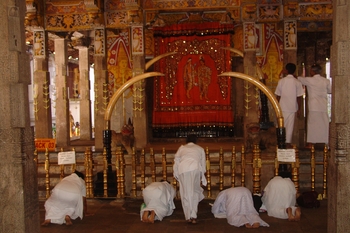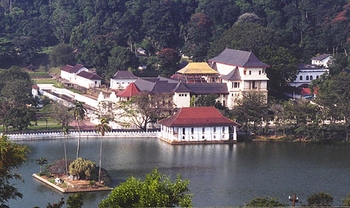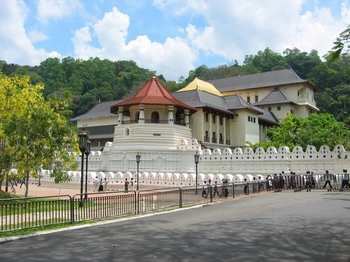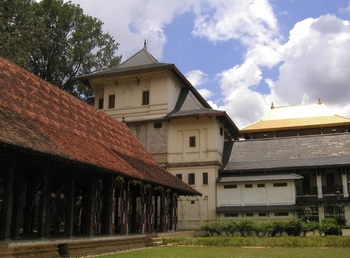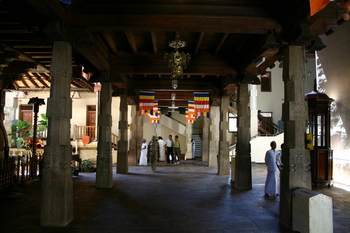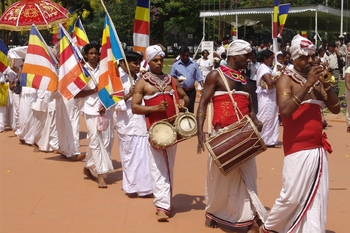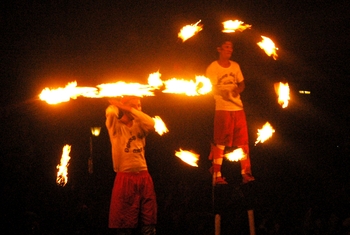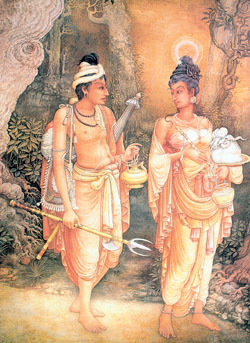
|
|||||||||||||||||||||||||||
|
| |||||||||||||||||||||||||||
Sri Dalada, Kandy Perehara and the Full Moon Poya Day of Esala
by Walter Wijenayake When the final passing away of the Sakyamuni Siddhartha Gauthama Buddha took place on the Full Moon Poya Day of Vesak, 2555 years ago, royal clans of Magadha, Kapilawasthu, Vishala and Ramagrama rushed to Kushinara and claimed their shares of the bodily relics of the Buddha. The Malla Royal Clan of Kusinara claimed the biggest share of the relics, as the Buddha came to their city to attain Parinibbana. Then there arose a quarrel among them for the purpose. At this juncture, a well known Pandit Brahmin named Drona came to the scene and preached Dhamma to the Kings. He said ‘It is not proper for you to fight for the relics of the Buddha’. Settling the dispute, he divided the relics of the Buddha into eight portions with the consent of the royalty present.
Mentioned are the different bodily relics (Sharirika Dathu) in question. After this exercise, all these relics together with all the other things used by the Buddha (Paribhogika Dhathu) were taken to all parts of India. Of all these invaluable objects of worship the sacred Tooth Relic which we found at present at the Sri Dalada Maligawa Kandy was with the King Guhasiva of Kalinga – Orissa in India. He sent this invaluable object – the sacred Tooth Relic, as a gift to his counterpart in Sri Lanka in about 313 through his daughter Hemamala and son-in-law Dantha, the son of King Udeni. Now, the Sri Dalada, the sacred Tooth Relic of the Buddha the most precious object of worship of the Buddhists all over the world, is housed in several golden caskets in the inner chamber of the Kandy Dalada Maligawa and protected with great veneration with offerings being made throughout the day at specific times by the Bhikkus of Malwatte and Asgiriya Chapter of the Siam Maha Nikaya nominated for the purpose. Further Buddhist devotees from all over the insland as well as from abroad including devotees of other faiths visit the Maligawa everyday to pay homage to the sacred Sri Dalada. These traditional customs prevailing to date, date back to the days of King Kirthi Mogawanna, also known as Kith Siri Mevan (303-331) in his ninth year of reign at Anuradhapura, at the time Sri Dalada was brought from Danthapura in Kalinga of India by Prince Dantha and Princess Hemamala disguised as a Brahim couple and reached Meghagiri Viharaya – a temple in Anuradhapura. It was at this place of worship that the Royal duo handed over the Sri Dalada to the King who received it with veneration to his care and placing it in an ornate casket brought to the city in a perahara and placed it at the Dhamma Chakka building which was later known as ‘Dhathughara’ which was constructed by King Devanampiyatissa. Successive Kings since that very beginning up to the capture of the Kandyan Kingdom by the British, venerated and protected it as it was accepted as the symbol of royalty. At present, the Sri Dalada is well placed under the care of its trustees the two Maha Nayaka Theras of Malwatte and Asgiriya Chapters of Siam Maha Nikaya and the Diya Wadana Nilame. The Perahara of Sri Dalada Maligawa in the present form is followed by the four Peraharas devoted to the four gods the (four Devivan wahanses) – Natha, Patthini, Kataragama and Vishnu carrying their insignias dating back to the reign of the King Kirthi Sri Rajasinghe (1749-1781). It is in recorded history that in the tenure of King Upatissa (426-468), the Sri Dalada was taken in procession from Abbayagiri Viharaya to the Maha Viharaya with great pomp and ceremony. In the year 820 when the Pandyans invaded the island and sacked and destroyed the capital, the Sri Dalada was shifted to a safer place. After the restoration of peace in the city, the King returned to the Kingdom. However, he moved the capital to Polonnaruwa, Sri Dalada also was taken to the new Kingdom of Polonnaruwa. In 1017 – The Chola invasion took place and King Malinda was defeated, and the Bhikkhus fled the Kingdom with the Sri Dalada to the South. King Vijayabahu, in 1056, defeated the invaders, acquiring power over the whole country, brought back the Sri Dalada to Polonnauwa. In this manner the sacred Tooth Relic had to undergo many a travail taking refuge in numerous secret places to ensure its safety from invaders for it is said that whoever possessed the sacred Tooth Relic will have divine power to rule the country. Once when the Bhikkhus came to know of a threat to the sacred Tooth Relic, by the Dutch, they secretly duplicated a tooth out of ivory and replaced it in the relic house and removed the Sacred Tooth Relic to safety. Thereby, the sacred Tooth Relic was saved from the vandals. When the Dutch captured the country, they found that the Sri Dalada was a hindrance for the advancement of Christianity and in the process destroyed the Palace at Kundasale but failed to lay their hands on the Sacred Dalada. The Catholics rejoiced, thinking that the Sri Dalada had been moved to Goa in 1561. The Archibishop of Goa placed it in a mortar and pulverised it, and burnt the powder and threw the ashes into a ditch. Sometime later, it was revealed that which was destroyed by the Archibishop was a replica of the real Sri Dalada. However, the sacred Tooth Relic was shifted to so many places for protection, such as Beligala, Dambadeniya, Polonnaruwa, Yapahuwa, Kurunegala, Kotte, Kuruwita, Kothmala, Ruhunu Rata, Delgamuwa, Pusulpitiya,Hindagala, Hanguranketha, Arattana and Kithulpe and after seventeen centuries to Senkadagala-Kandy Dalada Maligawa. When the leaders of the Uva Rebellion were captured in 1818, Rev. Wariyapola Sumangala Thero hid the sacred Tooth Relic in a bundle of clothes. However the British soldiers captured him and the Sri Dalada fell into the hands of the British and their rule was firmly established. The present Sri Dalada Maligawa in Kandy was built by King Narendrasinghe (1707-1781). Later the King Kirthi Sri Rajasinghe (1747-1781) attended to its repairs it. The Octagon together with the Kandy lake are the work of the King Sri Wickrema Rajasinghe (1798-1815). Since the arrival of the Sri Dalada at Anuradhapura, till it was sheltered at the Sri Dalada Maligawa, it is well known that it had not a fixed abode unlike other enshrined Relics. Whatever it is, the Sri Dalada had been in the Kandy Dalada Maligawa for about three centuries.
After the fall of the Kandyan Kingdom to the hands of the British, Governor Brownrigg conducted a perahara in great splendour. Henceforth the Sri Dalada Maligawa was guarded by the British soldiers. Hence on May 29, 1828, Governor Barnes conducted a perahara in the same way and handed over the Sri Dalada to the custody of the Kandyan chieftains. During the times of the Sinhala Kings, the Dalada Maligawa was managed by a layman bearing the title ‘Diyawadana Nilame’ who was designated ‘Diya Nilame’ (water presenting officer). Earlier the King carried out the rituals and the water bearer assisted the King. Formerly it was the King who appointed him. There was a time when the Diyawadana Nilame who together with two Maha Nayakas Theras of Malwatte and Asgiriya Chapters as custodians of the Sri Dalada was elected for life time. But the Buddhist Temporalities Act No. 19 of 1931 regularised the appointment of the Diyawadana Nilame, as that act declared that the Diyawadana Nilame was the custodian of the Dalada Maligawa and when a vacancy occurred, a successor had to be elected within three months. He can hold the office only for ten years. A month’s notice has to be given for the electors to gather at a particular place to select the new Diyawadana Nilame. Section 7 (2) of the act lays down the procedure to elect a new Diyawadana Nilame. Earlier Election Committee consisted of:
However, with some of the title and designations indicated in the Act being scrapped over time, those eligible to vote – those holding office as acting Divisional Secretaries, female and non-Buddhists have no voting rights. The candidate should be under 70 years of age and a Buddhist. The Returning Officer is the Commissioner of Buddhist Affairs. The voting is by secret ballot. Up to 1937 the office of the Diyawadana Nilame was a life time appointment. The term of office was limited to five years since 1937. In 1977 the term was increased to ten years, when Nissanka Wijeyaratne was the Diyawadana Nilame. Courtesy: The Island of 13 July 2011
| |||||||||||||||||||||||||||
